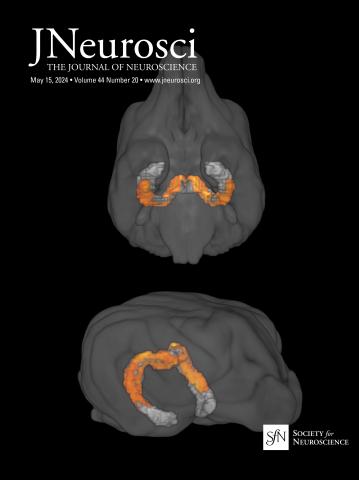Brain Topological Changes in Subjective Cognitive Decline and Associations with Amyloid Stages.
IF 4
2区 医学
Q1 NEUROSCIENCES
引用次数: 0
Abstract
This study examined how amyloid burden affects structural and functional brain network topology in subjective cognitive decline (SCD), a risk condition for Alzheimer's disease (AD). Functional and structural brain networks were analyzed in 100 individuals with SCD and 86 normal controls (both sexes included) using resting-state functional MRI and diffusion tensor imaging. Topological properties of brain networks were evaluated as indicators of information exchange efficiency and network robustness. Amyloid burden in 55 SCD participants was measured using amyloid PET imaging and a frequency-based staging method, which defined global and regional amyloid burden for four anatomical stages. Compared to normal controls, individuals with SCD exhibited increased functional nodal efficiency and structural nodal betweenness in the left anterior and median cingulate gyri, with no differences in network-level properties. Amyloid staging revealed four cortical divisions: stage 1, fusiform and lateral temporal gyri; stage 2, occipital areas; stage 3, default mode network (DMN), midline brain and lateral frontotemporal areas; and stage 4, the remaining cortex. The global and regional amyloid burden of each cortical stage were positively associated with the node-level properties of a set of DMN hubs, with the left anterior and posterior cingulate gyri being congruently associated with all amyloid stages. These findings suggest that amyloid burden continuously influences network adaptations through DMN hubs, irrespective of local proximity to pathology. Increased nodal properties in cortical hubs may reflect heightened information-processing demands during early amyloid deposition in this population at risk for AD.Significance Statement Amyloid spreads throughout the cortex in AD. It is unclear whether early amyloid deposition may trigger system-level network reorganization in SCD who are at risk for AD. We examined the brain topology alterations in SCD and its relationship with amyloid deposition at different cortical stages. We found increased node-level topological properties, in the core default mode network region (i.e., the cingulate cortex) in SCD. Increasing regional amyloid load at all stages showed consistent associations with the increasing node-level topological properties of the cingulate cortex in SCD. Our findings suggest that amyloid deposition impacts the system-level network adaptation via the cingulate cortex already at the very early stage and is unlikely to have a local effect in this AD risk population.主观认知能力下降的脑拓扑变化及其与淀粉样蛋白分期的关系。
本研究探讨了淀粉样蛋白负担如何影响阿尔茨海默病(AD)的一种危险状况——主观认知衰退(SCD)的结构和功能脑网络拓扑结构。使用静息状态功能MRI和弥散张量成像分析了100名SCD患者和86名正常对照者(包括男女)的功能和结构脑网络。脑网络的拓扑特性被评价为信息交换效率和网络鲁棒性的指标。使用淀粉样蛋白PET成像和基于频率的分期方法测量55名SCD参与者的淀粉样蛋白负荷,该分期方法定义了四个解剖阶段的整体和区域淀粉样蛋白负荷。与正常对照相比,SCD患者在左侧前扣带回和中扣带回的功能节点效率和结构节点之间表现出增加,但在网络水平上没有差异。淀粉样蛋白分期显示四个皮层分区:1期,梭状回和外侧颞回;第二阶段,枕区;第三阶段,默认模式网络(DMN),大脑中线和外侧额颞区;第四阶段,剩下的皮层。每个皮质阶段的整体和区域淀粉样蛋白负荷与一组DMN枢纽的淋巴结水平特性呈正相关,左侧扣带回前部和后部与所有淀粉样蛋白阶段一致相关。这些发现表明,淀粉样蛋白负荷通过DMN枢纽持续影响网络适应,而不考虑局部接近病理。皮层中心淋巴结特征的增加可能反映了阿尔茨海默病高危人群在早期淀粉样蛋白沉积过程中信息处理需求的增加。淀粉样蛋白在阿尔茨海默病患者的整个皮质中扩散。目前尚不清楚早期淀粉样蛋白沉积是否会引发有AD风险的SCD的系统级网络重组。我们研究了SCD的大脑拓扑改变及其与不同皮层阶段淀粉样蛋白沉积的关系。我们发现SCD的核心默认模式网络区域(即扣带皮层)的节点级拓扑特性增加。所有阶段区域淀粉样蛋白负荷的增加与SCD扣带皮层节点水平拓扑特性的增加一致。我们的研究结果表明,淀粉样蛋白沉积已经在非常早期的阶段影响了通过扣带皮层的系统级网络适应,并且不太可能在AD风险人群中产生局部影响。
本文章由计算机程序翻译,如有差异,请以英文原文为准。
求助全文
约1分钟内获得全文
求助全文
来源期刊

Journal of Neuroscience
医学-神经科学
CiteScore
9.30
自引率
3.80%
发文量
1164
审稿时长
12 months
期刊介绍:
JNeurosci (ISSN 0270-6474) is an official journal of the Society for Neuroscience. It is published weekly by the Society, fifty weeks a year, one volume a year. JNeurosci publishes papers on a broad range of topics of general interest to those working on the nervous system. Authors now have an Open Choice option for their published articles
 求助内容:
求助内容: 应助结果提醒方式:
应助结果提醒方式:


